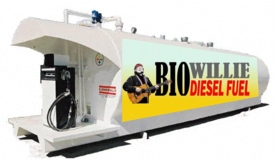Local Fuel Retailers are getting pinched
Posted By RichC on May 25, 2005

Above ground portable B20 pumps and tanks – BioWillie [clickable link]
In the US, the mom and pop gas station is steadily being replaced by conglomerate ‘fast food’ stations, grocery/superstore fuel pumps or oil company owned convenient gas stations. Often times the old private stations are franchised or leased, and the renewals are no longer automatic as was the case with the Franklin, Ohio Sunoco store. I chatted briefly with the proprietor shortly before he closed up shop; he indicated that 20 years at the same location meant nothing and corporate policy was to upgrade their Sunoco stores to exclude service facilities. In this case, Sunoco opted to close his full service station (with maintenance bays) because it no longer fit their interstate Sunoco store image. I believe they will eventually have a convenient store facility at that location.
For most owners of gas stations it has always been a serious challenge to make money on gasoline sales, but this is even more the case today. The margins have thinned to 7.7 cents per gallon according to a Lunberg Survey reported in the WSJ. This number is down from 2004’s average of 9.1 cents per gallon even in the face of extraordinary profits buy most oil companies. The trend has been for less focus and profit on fuel sales and more on convenient items. This was fine for most of the convenient style stations because much of their profit came from the sales of other items carrying 5 times the profit margin, until the high price of fuel began to also reduce customers spending on softdrinks, coffee, lottery tickets and junk food. Now many of the convenient stores are feeling pinched at both ends and the only expansion in fuel retailing is with the grocery and superstores.
Local grocerers, Krogers and Meijers both sell fuel, some Walmart stores offer fuel as does Costco. These companies have seen their market share is growing at 20% per year according to Energy Analysis International while the majors (Exxon Mobil, ConocoPhillips and Royal Dutch Shell) have reduced their station count from 22,000 locations in 2001 to 16,000 today. Often the grocery and superstores are undercutting their stand alone competitors to sell fuel and are making it up in volume and in-store sales. But … those stores too are feeling the pinch of what high fuel prices do to the spending habits of their customers. No long do we have the extra few dollars to spend on non essential items in the grocery or superstore. Even Walmart admits that the disappointing first quarter is due to their customers needing to spend their extra dollars to fill there tank.
The final straw in the retailing of gasoline is how consumers pay for their purchases. Years ago it wasn’t uncommon for most consumers to pay for their purchase with cash. Now the credit card as replaced cash as the preferred method of payment. The cost to the station for this convenience is approximately 3 cents on every dollar or 3%. Considering the margins has just shrunk to 7.7 cents per gallon on their fuel, losing another 3 cent reduces the profit to under 5 cents per gallon. That’s not much margin no matter what retail business you are in.
Comments